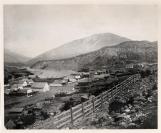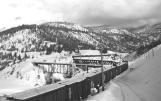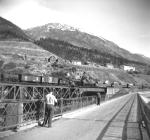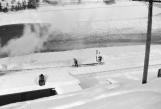1
The railroad joining Eastern Canada to the West Coast was a promise of Confederation in 1867. It took many years, but was finally completed in 1885. The Fraser Canyon was one of the most difficult and dangerous sections to construct.2
Railway construction contracts were let and construction began.An American civil engineer named Andrew Onderdonk won the contracts extending from Port Moody to Savona. He quickly established his headquarters at Yale and started the roadbed.
Onderdonk soon found that the lack of sufficient workers was impeding the railroad's progress. He needed more workers and made a desperate move to get them. He notified Ottawa that he needed 2,000 Chinese labourers. Without bothering to wait for a reply, he chartered two steam ships to go to China and bring back the needed workers. The ships returned with their human cargo and they were quickly transferred to stern wheelers and rushed up the Fraser to Yale before government officials had a chance to object.
These workers formed the bulk of his labour force. They were joined by others of their countrymen and the labour gangs grew until there were 5,000 men working between Yale and Boston Bar, the majority being Chinese.
The Chinese were paid $1 per day, while others received $2 per day. All workers received meals and accommodation.
4
The beautiful stone bridges and retaining walls built for the Canadian Pacific Railway are still in every-day use, and supporting loads in great excess of anything conceived of when they were built.5
The Canadian Pacific track showing one of the original stone bridges.29 August 2004
Near Hell's Gate on the Fraser River

8
The Canadian National Railway was constructed through Lytton in 1910. Better machinery and concrete meant that construction was a little less labour intensive and bridges were steel and concrete, rather than stone.10
CNR TrestleThe bridge crossing the Fraser River at the south end of Lytton was originally designed to have a walkway. The plan also called for a large underground crossing passing through the railway embankment. These were designed so that people could cross the river without trespassing on the railway right of way.
The Canadian Northern Railway never did complete the footpath or the culvert when they built the bridge. It was rumored that the steel for these projects was stored in the Canadian Northern yards, but that the advent of W.W.I in 1914 caused the steel to be remanufactured into war materials.
When the Canadian National took over the Canadian Northern Railway, the project seems to have been lost in the shuffle.
That being as it may, people were still using the trestle as a walkway. When a train came, anyone on the bridge had to run to the nearest of the fire barrels which were placed on tiny platforms projecting from the side of the trestle. There, one had to hang on to the barrel while having barely enough room for one's feet. There was no protection from falling into the river or onto the rocky shore many feet below.
Tragedies did happen, and the luckless ones who could not reach a barrel would be hit by the train, which could not stop in time, resulting in the victim either being pushed over the edge of the trestle or being run over by the train. Usually the results were the same -- a coroner's inquest.
Concerned about the frequency of accidents, the Lytton Lions Club promoted a campaign to provide a walkway. This effort resulted in a joint venture between the CNR and the Ministry of Highways which provided the needed safety path, almost eliminating fatalities on the trestle.
The underpass beneath the track was never completed. Instead a level crossing was installed near the end of the bridge to allow a safer crossing.
11
A train steams across the Canadian National Bridge across the Fraser River at Lytton.1920
Lytton, BC







